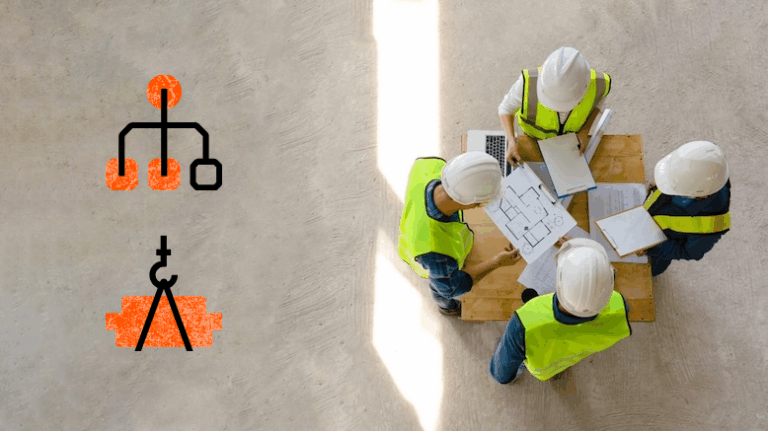— 6 min read
Orchestrating Order: Logistics Strategies for Civil Construction


Last Updated Aug 14, 2025

Makenna Ryan
Civil & Infrastructure Solutions Engineer
Makenna Ryan is a Solutions Engineer at Procore. Prior to joining Procore, he spent seven years at McDermott International Inc. as a construction Manager and Senior Equipment Engineer. He also spent three years as a Project Engineer at Subsea7. Makenna received his B.S. in Mechanical Engineering and Technology from Texas Tech University. He is based in the Houston area.

Marlissa Collier
33 articles
Marlissa Collier is a journalist whose work focuses on the intersections of business, technology, policy and culture. Her work has been featured in digital and print formats with publications such as the Dallas Weekly, XO Necole, NBCU Comcast, the Dallas Nomad, CNBC, Word in Black and Dallas Free Press. Marlissa holds an undergraduate degree in Construction Engineering from California State University, Long Beach and an MBA from Southern Methodist University’s Cox School of Business.
Last Updated Aug 14, 2025

Civil construction projects stand as testaments to human ambition and engineering prowess. From soaring bridges to complex subterranean railway networks, these endeavors operate on a massive scale, often involving thousands of workers, intricate equipment, and a colossal volume of materials.
The key to keeping these complex systems running on time and on budget lies in a strategic blend of meticulous planning and unwavering logistical coordination. In the high-stakes world of civil construction, logistics is not merely a support function — it is the very backbone of success.
Table of contents
The Massive Scale of Civil Logistics
Civil construction is fundamentally a supply chain challenge on an epic scale.
A single project can involve anywhere from 300 to over 5,000 workers. The sheer logistics of managing this workforce — from daily transportation and shift changes to providing meals and managing access controls — is a project in itself.
This human element is just one piece of the puzzle. The flow of materials, which can range from millions of cubic yards of earth to pre-fabricated structural components weighing hundreds of tons, must be precisely timed. A delay in a single delivery can have cascading effects, idling crews and machines and adding millions to a project's cost.
The challenges are often compounded by external factors, such as volatile material prices, supply chain bottlenecks and the need for specialized equipment that may not be readily available. A study on logistics challenges in the construction industry highlights that a lack of in-transit visibility and poor collaboration between suppliers and site managers are major causes of project delays and cost overruns.
Therefore, a successful logistics strategy must not only manage the known variables but also build in resilience against the unexpected.
Coordinating Labor, Equipment & Materials
Effective coordination is the foundation of any large-scale project.
The core logistical challenge is synchronizing the labor force with the materials and machinery they need to do their jobs. Union rules, subcontractor schedules and the rotation of specialized teams all require a logistical "choreography" that everyone and everything is in the right place at the right time. This illustrates that the logistical heavy lifting begins long before the first piece of concrete is poured.
This choreography extends to the materials themselves. For a project as complex as the London Crossrail, or Elizabeth Line, which involved digging 42 km of new tunnels under a bustling city, the coordination was a masterpiece of urban logistics.
Tunnel boring machines had to navigate existing underground infrastructure with precision, and the massive amount of excavated earth had to be removed without disrupting daily life above ground. The project successfully used the excavated material to create new wildlife reserves, showcasing an innovative approach to reverse logistics and waste management.
Explore data and trends for building materials prices.
Get the latest U.S. retail prices and view historical trends for common building materials.
The Importance of Sequencing
Construction sequencing is a vital step to any organized project, and this is especially true for infrastructure work. On earthwork-heavy infrastructure projects, millions of cubic yards of dirt must be moved and managed in a carefully sequenced manner.
For example, earthmoving operations must be completed before bridge materials can be brought onsite. A misstep in sequencing can create delays, increase costs — and even compromise safety.
A prime example of sequencing on a historic scale is the construction of the Hoover Dam. Before the dam could be built, the Colorado River had to be diverted. This required the excavation of four massive tunnels through the canyon walls.
The entire construction process was a series of carefully sequenced steps, from diverting the river and excavating the riverbed to pouring concrete in individual columns and installing a complex cooling system to prevent the concrete from cracking as it cured. This intricate dance of tasks and resources highlights that a single project is often a series of smaller, sequential projects, each with its own logistical demands.
Even organizing dirt has choreography. Everything’s got to dance together.

Makenna Ryan
Civil & Infrastructure Solutions Engineer
Procore
Tech Tools for Planning and Coordination
To maintain order amidst the chaos of complex civil jobsites, teams rely heavily on advanced planning and project management tools. Software can serve as a "single source of truth," enabling stakeholders to track progress and make real-time adjustments. These platforms can be a huge leg up for creating the detailed schedules that serve as the project's "heartbeat."
Modern civil construction utilizes a new generation of digital platforms for solutions beyond scheduling. These cloud-based solutions for construction site logistics allow teams to create and visualize comprehensive site plans and simulations. This technology promotes an inclusive planning process, enabling real-time collaboration and helping stakeholders visualize the intricate sequencing of a project.
These platforms can also centralize documents, manage daily logs, and provide real-time data that seamlessly links office teams with on-site workers.
Real-World Examples: Case Studies in Logistics
The logistical complexity of civil construction is best understood through its landmark projects.
- The Big Dig (Boston, USA): This multi-decade infrastructure project was a logistical nightmare and a masterclass in urban construction. Rerouting the central artery of a major city underground required intricate sequencing and coordination between ongoing utility operations, tunnel boring, and bridge construction. Delays in one area had a ripple effect, underscoring the critical need for a clear schedule and adaptive planning.
- The Hong Kong-Zhuhai-Macau Bridge (China): The world's longest sea-crossing bridge and tunnel system, this project involved constructing a 55 km structure across open water. The logistics of building artificial islands, transporting massive prefabricated tunnel sections, and managing materials on the water in a busy shipping lane were unprecedented. The project utilized non-dredge reclamation methods to protect marine ecology and introduced a floating concrete batching plant to ensure a consistent supply of high-quality concrete.
- The Panama Canal Expansion (Panama): A modern parallel to the original canal's monumental task, the expansion project involved moving immense amounts of earth and rock in a challenging tropical environment. This demanded rigorous coordination of barge logistics, excavation sequencing, and round-the-clock crew rotations. The project’s success hinged on its ability to manage a vast, international supply chain for materials and equipment while maintaining the operations of the existing canal.
Daily Discipline and Friction Removal
Ultimately, great logistics in civil construction comes down to daily discipline. Job sites that start each day with a visual plan review, clearly marked work zones, and efficient check-in processes often outperform their counterparts. This consistency builds a culture of order and proactive problem-solving.
If we know there’s a concrete pour in the morning, we clear the path the night before. Logistics is thinking ahead.
Makenna Ryan
Civil & Infrastructure Solutions Engineer
Procore
The final — and perhaps most important — component of a successful logistics strategy is friction removal.
Friction removal is the practice of anticipating and eliminating blockers before they can cause delays. Whether it’s clearing a path the night before a major concrete pour or ensuring a delivery truck has a designated entry point, great logistics is about thinking ahead and creating an environment where work can proceed without unnecessary obstacles.
By creating systems that value both structure and improvisation, civil construction teams can overcome logistical obstacles and keep even the most complex projects on track.
Was this article helpful?
Thank you for your submission.
0%
0%
You voted that this article was . Was this a mistake? If so, change your vote
Scroll less, learn more about construction.
Subscribe to The Blueprint, Procore’s construction newsletter, to get content from industry experts delivered straight to your inbox.
By clicking this button, you agree to our Privacy Notice and Terms of Service.
Thank you!
You’re signed up to receive The Blueprint newsletter from Procore. You can unsubscribe at any time.
Categories:
Written by

Makenna Ryan
Civil & Infrastructure Solutions Engineer | Procore
Makenna Ryan is a Solutions Engineer at Procore. Prior to joining Procore, he spent seven years at McDermott International Inc. as a construction Manager and Senior Equipment Engineer. He also spent three years as a Project Engineer at Subsea7. Makenna received his B.S. in Mechanical Engineering and Technology from Texas Tech University. He is based in the Houston area.
View profile
Marlissa Collier
33 articles
Marlissa Collier is a journalist whose work focuses on the intersections of business, technology, policy and culture. Her work has been featured in digital and print formats with publications such as the Dallas Weekly, XO Necole, NBCU Comcast, the Dallas Nomad, CNBC, Word in Black and Dallas Free Press. Marlissa holds an undergraduate degree in Construction Engineering from California State University, Long Beach and an MBA from Southern Methodist University’s Cox School of Business.
View profileExplore more helpful resources

Bid Management Software: Key Features & How to Choose the Right Fit
Bidding on construction projects can be a complex process. Sourcing appropriate bids and requests for proposals, analyzing bid documents, making sure estimates, preliminary schedules, and other mandatory requirements are met...

From “What Is” to “What If” in Construction
In this episode of The Power of Construction, futurist Nikolas Badminton challenges the industry to reimagine what’s possible when we move from “what is” to “what if.” Rather than planning...

Transforming Construction Project Management With Predictive Analytics
Construction leaders who can correctly identify project challenges before they arise can more easily sidestep them. This saves time, money and significant delays. Predictive analytics attempts to forecast future outcomes...

Capital Project Management: A Quick Guide for Construction Pros
With aging infrastructure and new technology needs, capital projects will remain a high priority for communities around the world in the coming years. Effectively managing capital construction projects is necessary...
Free Tools
Calculators
Use our calculators to estimate the cost of construction materials for your next project.
Templates
Find a template to help you with your construction project tasks.
Material Price Tracker
Get the latest U.S. retail prices and view historical trends for common building materials.
Glossary
Explore key terms and phrases used in the industry.
